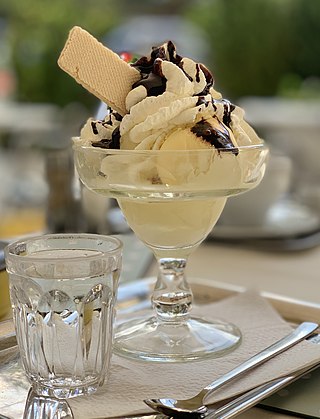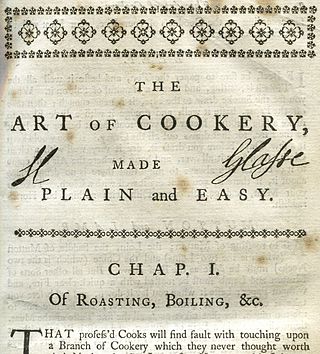
Ice cream is a frozen dessert typically made from milk or cream that has been flavoured with a sweetener, either sugar or an alternative, and a spice, such as cocoa or vanilla, or with fruit, such as strawberries or peaches. Food colouring is sometimes added in addition to stabilizers. The mixture is cooled below the freezing point of water and stirred to incorporate air spaces and prevent detectable ice crystals from forming. It can also be made by whisking a flavoured cream base and liquid nitrogen together. The result is a smooth, semi-solid foam that is solid at very low temperatures. It becomes more malleable as its temperature increases.

Trifle is a layered dessert of English origin. The usual ingredients are a thin layer of sponge fingers or sponge cake soaked in sherry or another fortified wine, a fruit element, custard and whipped cream layered in that order in a glass dish. The contents of a trifle are highly variable and many varieties exist, some forgoing fruit entirely and instead using other ingredients, such as chocolate, coffee or vanilla. The fruit and sponge layers may be suspended in fruit-flavoured jelly, and these ingredients are usually arranged to produce three or four layers. The assembled dessert can be topped with whipped cream or, more traditionally, syllabub.

Mrs. Mary Eales's Receipts was published in London in 1718 and again in 1733, the second time also under the title of The compleat confectioner. It was published in 1744 with an additional called A curious collection of receipts in cookery, pickling, family physick, &c. added by the publisher, R. Montagu. A facsimile of the 1733 edition was published in 1985 by Prospect Books (ISBN 0-907325-25-4).

Ratafia is a broad term used for two types of sweet alcoholic beverages, a flavouring essence whose taste resembles bitter almonds, later to a ratafia flavoured biscuit, a biscuit to be eaten along with ratafia, and later still, to a cherry variety.

Eliza Acton was an English food writer and poet who produced one of Britain's first cookery books aimed at the domestic reader, Modern Cookery for Private Families. The book introduced the now-universal practice of listing ingredients and giving suggested cooking times for each recipe. It included the first recipes in English for Brussels sprouts and for spaghetti. It also contains the first recipe for what Acton called "Christmas pudding"; the dish was normally called plum pudding, recipes for which had appeared previously, although Acton was the first to put the name and recipe together.

Hannah Glasse was an English cookery writer of the 18th century. Her first cookery book, The Art of Cookery Made Plain and Easy, published in 1747, became the best-selling recipe book that century. It was reprinted within its first year of publication, appeared in 20 editions in the 18th century, and continued to be published until well into the 19th century. She later wrote The Servants' Directory (1760) and The Compleat Confectioner, which was probably published in 1760; neither book was as commercially successful as her first.

The Compleat Housewife; or, Accomplish'd Gentlewoman's Companion is a cookery book written by Eliza Smith and first published in London in 1727. It became popular, running through 18 editions in fifty years.
Augustus Jackson, was an African American businessperson, chef, ice cream maker, and confectioner from Philadelphia, Pennsylvania. He is credited as inventing a modern method of manufacturing ice cream and for new flavor development. He is nicknamed “the Father of Ice Cream”, despite not inventing ice cream. Jackson served for twenty years as a chef at the White House in Washington, D.C., before opening his own catering and confection business.

Elizabeth Raffald was an English author, innovator and entrepreneur.

A New System of Domestic Cookery, first published in 1806 by Maria Rundell, was the most popular English cookery book of the first half of the nineteenth century; it is often referred to simply as Mrs Rundell, but its full title is A New System of Domestic Cookery: Formed Upon Principles of Economy; and Adapted to the Use of Private Families.
Elizabeth David, the British cookery writer, published eight books in the 34 years between 1950 and 1984; the last was issued eight years before her death. After David's death, her literary executor, Jill Norman, supervised the publication of eight more books, drawing on David's unpublished manuscripts and research and on her published writings for books and magazines.

Maria Eliza Rundell was an English writer. Little is known about most of her life, but in 1805, when she was over 60, she sent an unedited collection of recipes and household advice to John Murray, of whose family—owners of the John Murray publishing house—she was a friend. She asked for, and expected, no payment or royalties.

The Experienced English Housekeeper is a cookery book by the English businesswoman Elizabeth Raffald (1733–1781). It was first published in 1769, and went through 13 authorised editions and at least 23 pirated ones.

Modern Cookery for Private Families is an English cookery book by Eliza Acton. It was first published by Longmans in 1845, and was a best-seller, running through 13 editions by 1853, though its sales were later overtaken by Mrs Beeton. On the strength of the book, Delia Smith called Acton "the best writer of recipes in the English language", while Elizabeth David wondered why "this peerless writer" had been eclipsed by such inferior and inexperienced imitators.

Elinor Fettiplace's Receipt Book is a 1986 book by Hilary Spurling containing and describing the recipes in a book inscribed by Elinor Fettiplace with the date 1604 and compiled in her lifetime: the manuscript contains additions and marginal notes in several hands. Spurling is the wife of a descendant of Fettiplace who had inherited the manuscript. The book provides a direct view of Elizabethan era cookery in an aristocratic country house, with Fettiplace's notes on household management.

The Cooks and Confectioners Dictionary: or, the Accomplish'd Housewives Companion was a cookery book written by John Nott and first published in London in 1723.

The Queen-like Closet, Or, Rich Cabinet was a cookery book published in 1670 by the English writer on household management, Hannah Woolley. It ran through five English editions by 1684. At least two German editions were also printed.
Elinor Fettiplace was an English cookery book writer. Probably born in Pauntley, Gloucestershire into an upper class land-owning farming family, she married into the well-connected Fettiplace family and moved to a manor house in the Vale of White Horse, in what was then Berkshire.

Martha Bradley was a British cookery book writer. Little is known about her life, except that she worked as a cook for over thirty years in the fashionable spa town of Bath, Somerset.

The Lady's Complete Guide, or Cookery in All its Branches by Mary Cole is a pioneering cookery book, the first in English that systematically ascribed recipes to their authors, where known. It was first published in 1788 and was followed by revised editions in 1789 and 1791.

















